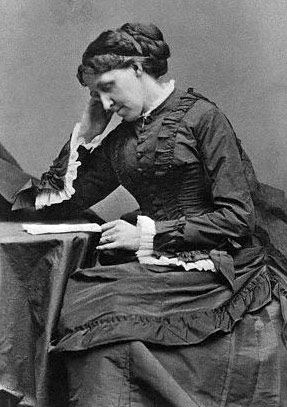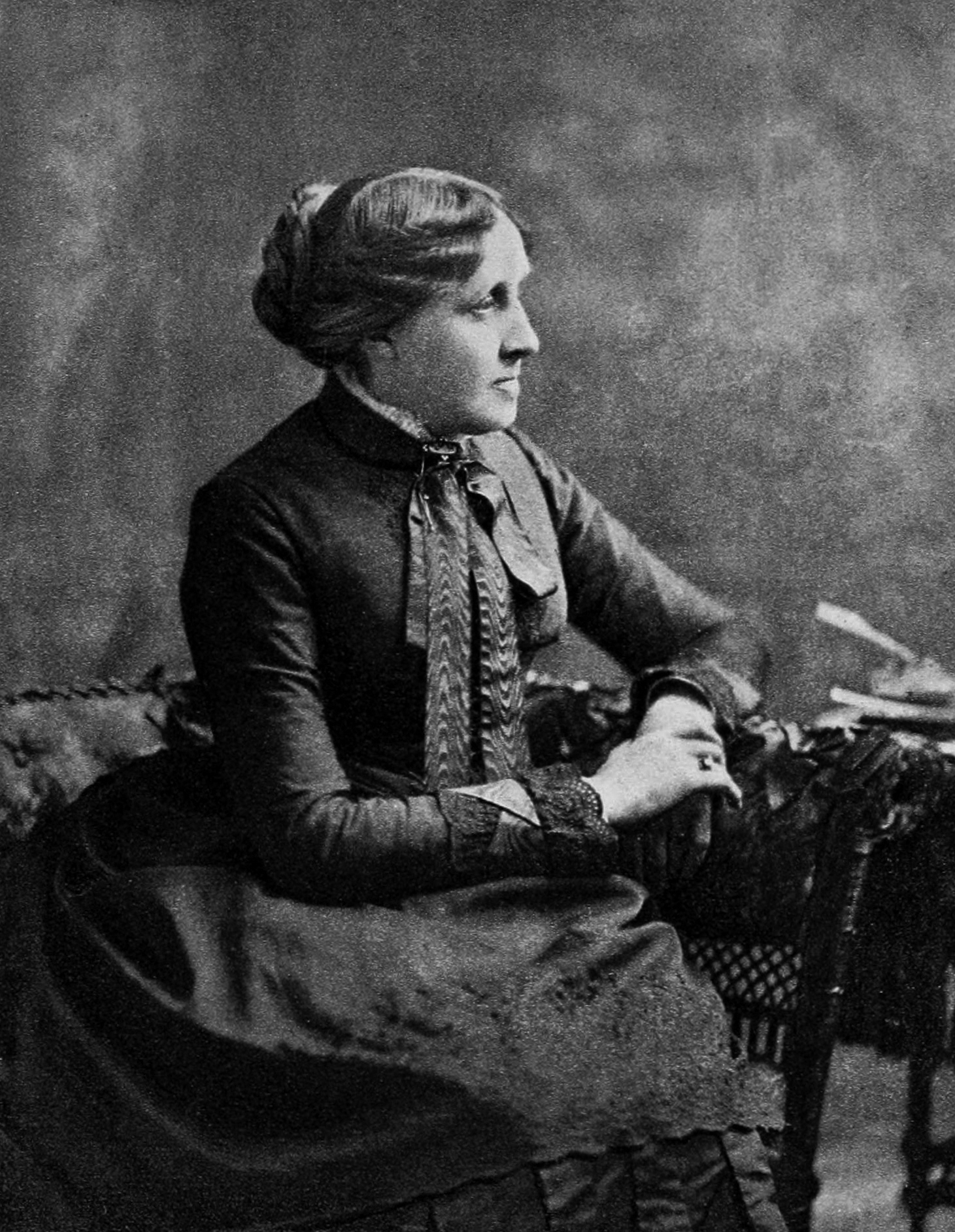
If anyone could be said to have really written in a garret, alone and oblivious, it is Louisa May Alcott.
The most common cultural image recalled with the phrase “the author” is the romantic genius, alone in his garret, writing furiously, crumpling up papers and throwing them on the floor, losing track of time, heedless of the public, obsessed with his own imagination. In this archetypal scene, the author is anything but domestic.
 The most common cultural image of domesticity is a house, children, mother, father, and a hearth. Perhaps the children are seated on the parlor floor, listening to their father tell a story. Or they are cavorting in snow in the front of a well-lit house while mother prepare dinner and father reads. In the American popular imagination, the novel that typifies this domestic scene is Louisa May Alcott’s Little Women.
The most common cultural image of domesticity is a house, children, mother, father, and a hearth. Perhaps the children are seated on the parlor floor, listening to their father tell a story. Or they are cavorting in snow in the front of a well-lit house while mother prepare dinner and father reads. In the American popular imagination, the novel that typifies this domestic scene is Louisa May Alcott’s Little Women.
But here is a funny thing: if anyone could be said to have really written in a garret, alone and oblivious, it is Alcott. A passage from Little Women is almost a parody of the romantic artist cliché, and based upon Alcott’s own experience. Here, Jo, the character that most resembles Alcott, describes her writing process:
Every few weeks she would shut herself up in her room, put on her scribbling suit, and “fall into a vortex,” as she expressed it, writing away at her novel with all her heart and soul, for till that was finished she could find no peace…When the writing fit came on, she gave herself up to it with entire abandon, and held a blissful life, unconscious of want, care, or bad weather, while she sat safe and happy in an imaginary world, full of friends almost as real and dear to her as any in the flesh. Sleep forsook her eyes, meals stood untasted, day and night were all too short to enjoy the happiness which blessed her only at such times…The divine afflatus usually lasted a week or two, and then she emerged from her “vortex” hungry, sleepy, cross, or despondent.”
Alcott, the woman who most Americans associate with ur-domesticity, exemplified the romanticism of the tortured artist. Why is our image of her so dissonant with her actual experience?
Alcott is due for a reassessment, and luckily for us others are hard at work correcting the historical record. Alcott’s life was fantastically brought to life in 2007 by John Matteson in his Pulitzer Prize winning Eden’s Outcasts: The Story of Louisa May Alcott and Her Father. A new film by Nancy Porter and Harriet Reisen Louisa May Alcott: The Woman Behind Little Women, gives us more insight. The film, which will air on PBS in the fall, renders Alcott’s life in all its complexity. It is currently being screened at festivals: you can see it and at Reel Women Film Festival in Los Angeles at the end of March.
*****
The differences between Alcott’s life and the novel are many. To name a few: Alcott never married, and Jo does. Alcott wrote her whole life, mainly penning commercial work she would prefer not to write, because she had to support her sick mother and financially challenged father, Bronson. The novel she most wanted to succeed was Moods, her first work, a philosophical, metaphysical novel, not the sweet story for girls she is best remembered by. Jo, on the other hand, abandons her dream of becoming a writer to marry and teach at a boy’s school.
Louisa’s father, Bronson Alcott, a vegan who once swore off wool because he did want to offend the sheep, was an influential but comical figure, a Transcendentalist who cast an enormous shadow over Louisa’s life and who relied on others, including Emerson and his daughter Louisa, to support him. Bronson was renowned for hanging out on a bench outside his house eager to chat with any passersby. (His neighbor Nathaniel Hawthorne wrote a poem about him: “There lived a Sage at Appleslump/Whose dinner never made him plump;//Give him carrots, potatoes, squash, turnips and peas, /And a handful of crackers without any cheese, /And a cup of cold water to wash down all these, /And he’d prate of the Piritit as long as you please, This airy Sage of Appleslump.”).
Mr. March, on the other hand, valiantly fights in the Civil War and, once he returns, nicely fades into the background.
In other words, the Alcott family was, to most of middle-class mainstream America at the time (and perhaps would be so considered today, still) a bunch of weirdo radicals who supported John Brown, progressive education and, half a century before suffragism, Women’s Rights. They were anything but the idealized American family misremembered in American memory as the Marches.
****
According to a wildly unscientific poll I conducted, most men have not read Little Women. Which might be why I never read it when I was younger. I was a tomboy, and considered myself a serious reader. Why waste my time on a prissy book for girly girls?
Perhaps I should have read a biography of Alcott, instead. Louisa’s adult life is a story of her struggle to balance the sometimes oppressive needs of her family with her desire to live independently and write whatever she wanted to. Writing was the main source of money for herself and her parents after her sisters all moved out of the house. Louisa, who always envisaged for herself what Jo also wanted-an independent life-was the one stuck at home taking care of her aging parents In 1866, when her mother, Abba, was quite ill, Bronson off went to give lectures in St. Louis and hang out with friends. Louisa stayed with Abba and wrote to pay the bills.
She wrote Little Women while taking care of her ill mother at the suggestion of her publisher. Alcott was initially hesitant: “I don’t enjoy this sort of thing,” she said. “Never liked girls or knew many, except my sisters”
Whenever her parents were doing okay financially and medically, and could spare her, she would move to Boston where she had rented a room she dubbed “Gamp’s Garrett,” a reference to Charles Dickens’ Martin Chuzzlewhit.
In Little Women, Jo is left in the house after her sisters marry off She reflects on her fate:
“Poor Jo! These were dark days to her, for something like despair came over her when she thought of spending all her life in that quiet house, devoted to hum-drum cares, a few poor little pleasures, and the duty that never seemed to grow any easier. “I can’t do it. I wasn’t meant for a life like this, and I know I shall break away and do something desperate if somebody don’t come and help me,” she said to herself… and she fell into the moody, miserable state of mind which often comes when strong wills have to yield to the inevitable.”
In her garret, Louisa wrote a poignant counterpoint to Little Women, an essay called “Happy Women.” In it, she offers an ironic slant on her famous novel’s title. She profiles four “superior” women who decided not to marry, and wrote to her young girl readers that “liberty is a better husband than love to many of us,” particularly in the case of “the loss of happiness and self-respect that comes with an ill considered marriage.” The women she profiles chose to remain single: they were a doctor, a missionary a music teacher, and an author, based upon herself.
In Little Women, the March sisters subscribe to the Alcottian ideals of self-sacrifice and familial duty, but also strive for independence, aiming to succeed at whatever endeavor they most desire, be it traditionally feminine and domestic, as with Amy and Beth, who want to marry and tend house, respectively, or unconventional, as with Meg and Jo, who want to become artists.
After Louisa published part I of Little Women, she received letters from girls who loved the book. But most were most anxious to know whom the girls would end up with. Most hoped Jo would marry the dashing Laurie.
Louisa’s publishers wanted her to pair the two off, too, but Louisa did not want Jo to marry at all. But she eventually compromised by having Jo marry the older, intellectual Professor Bhaer.
****
Louisa kept writing about the March family in the many sequels to Little Women. In Jo’s Boys, she makes the school Jo teaches at, Plumfield, co-educational, and limns her views of Women’s Rights more forcefully. A college is added to Plumfield that admits all, regardless of race or religion. Nan, the first girl student at Plumfield, refuses advances from a boy and stays unmarried, happily so, and becomes a doctor.
Jo’s Boys was written fifteen years after Little Women, and Louisa could not wait to be done with the Marches. She felt her readers had reduced Jo, and by proxy Louisa, to “a literary nurse maid who provides moral pap for the young” (420).
I finally read Little Women, through the prism of my newly found knowledge of Alcott’s life. I was enthralled by the novel’s complexity, the struggles of girls to balance self-determination with filial duties. With Alcott’s full story told, maybe boys and men will read it, too, and Little Women will be deemed not so little, after all.
****
ALSO READ: Eula Biss writes about Louisa May Alcott, the mythical American frontier, and Chicago’s Rogers Park neighborhood over in The Believer.




